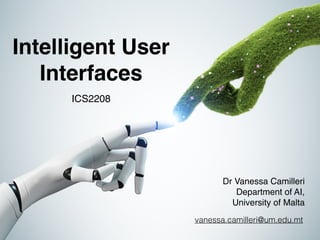
ICS2208 Lecture4
- 1. Intelligent User Interfaces ICS2208 vanessa.camilleri@um.edu.mt Dr Vanessa Camiller i Department of AI, University of Malta
- 2. Topic 4: Overview • Agents & Intelligent Agents • Agent Models • Bene fi ts of user adaptivity • Usability challenges • Collecting data from users • Future needs in IUI’s 2
- 3. Agents & Intelligent Agents • Complex systems: Arti fi cial vs. Natural • Intelligent Agents: autonomous & cooperative • Environment as the problem space: deterministic vs. stochastic • Uses a perception of the environment status to take decisions • Uses and provides functions
- 4. Agents & Intelligent Agents • Important characteristics of agents include: • Rationality; agent acts to achieve goals, taking the right decision in every situation • Behaviour depends on (a) performance measure, (b) knowledge of environment, (c) sequence of perceptions • Autonomy; agent takes initiative with a non-trivial degree of control over its actions
- 5. Agent Models • Simple Re fl ex; decision based on current perception • Model-based Re fl ex; when the world is not fully observable • Goal-based; agent is wholly dedicated to achieving end goals, no matter how complex • Utility-based; similar to goal-based but agent knows the utility function • Learning; knowledge is expanded learning from past experiences
- 6. Agent Environment Space • Observable • Deterministic • Dynamic • Discrete • Multiagent
- 7. Agent Environment Space The Design Perspective • Basic - agents access their deployment context directly • Abstraction - fi lling in conceptual gap between agent abstraction and deployment context • Interaction/Mediation - supporting both perspectives and support coordination between agents
- 8. Agent Interactions Agent viewed as ‘the one who acts’ • Situated; being immersed in an environment • Social; reconciles individual cognitive processes and social coordinations • Simulated; dynamic processes of agent interaction repeated over time
- 9. Interface Agents Why design them? • To improve communication between humans and computers. • To enhance the fl exibility, usability, and power of human-computer interaction for all users. HCI scientists exploit knowledge of users, tasks, tools, and content, as well as devices for supporting interaction within different contexts of use. 9
- 10. In simple terms, an intelligent interface agent provides a way for a system to learn something about each individual user and adapt its behaviour to them in some nontrivial way.
- 11. • Amazon adapts its recommendation system to the user’s previous history of purchase. Depending on their function and form, systems that adapt to their users have been given labels ranging from adaptive interfaces through user modelling systems to software agents or intelligent agents. • However a common property binding these systems or agents is user-adaptivity
- 12. Systems where the intelligence lies mainly in UIs • Systems with adaptive user interfaces that are automatically adapted to the inferred capabilities or needs of the user. • Multimodal systems that aim to enable more natural, human-like forms of input and output. • Systems with human-like virtual characters that enable the user to interact with a system in a way that is partly similar to human- human interaction. • Smart environments in which embedded objects interact intelligently with their users. • Personalised websites, in which the displayed content is adapted to the inferred interests of the user.
- 13. Systems where the intelligence lies mainly behind UIs • Recommender systems, which present products, documents, or other items that are expected to be of interest to the current user. • Systems that employ intelligent technology to support information retrieval. • Learning environments that offer learning assistance on the basis of assessments of each learner’s capabilities and needs. • Interface agents that perform complex or repetitive tasks with some guidance from the user. • Situated assistance systems that monitor and support a user’s daily activities. • Systems for capturing knowledge from domain experts who are not knowledge engineers. • Games that make use of AI technology to create the opponents against which the human players play.
- 14. General schema for the processing in a user adaptive system (Dotted arrows: use of information; solid arrows: production of results.)
- 15. • A user-adaptive agent system can be de fi ned as: An interactive system that adapts its behaviour to individual users on the basis of processes of user model acquisition and application that involve some form of learning, inference, or decision making
- 16. Overview of adaptation in amazon
- 17. Interface pro-activity continuum; moving towards a completely automated and intelligent task completion
- 18. Bene fi ts of user-adaptivity: Functions: supporting system use • Taking over parts of routine tasks; • Adapting the interface; • Helping with system use; • Mediating interaction with the real world; • Controlling a dialog;
- 19. Bene fi ts of user-adaptivity: Functions: supporting information acquisition • Helping users fi nd information; • Recommending products; • Tailoring information presentation; • Supporting collaboration; • Supporting learning;
- 20. Use of Data Collected • The key difference between user-adaptive systems and other interactive systems is the inclusion of some method for acquiring and exploiting a user model. • What is needed are (a) some implementation of the adaptation algorithm, not necessarily embedded in any interactive system; and (b) a database of behavioural data from a number of users who have used a relevant nonadaptive system. The researcher can then apply the modelling method to the data in order to determine how well the system would adapt to the users in question.
- 21. Future of User-adaptive Systems • Growing need for user-adaptivity; • Diversity of Users and Contexts of Use • Number and Complexity of Interactive Systems • Scope of Information to Be Dealt With
- 22. Future of User-adaptive Systems • Increasing Feasibility of Successful Adaptation • Ways of Acquiring Information About Users • Advances in Techniques for Learning, Inference, and Decision • Attention to Empirical Methods
